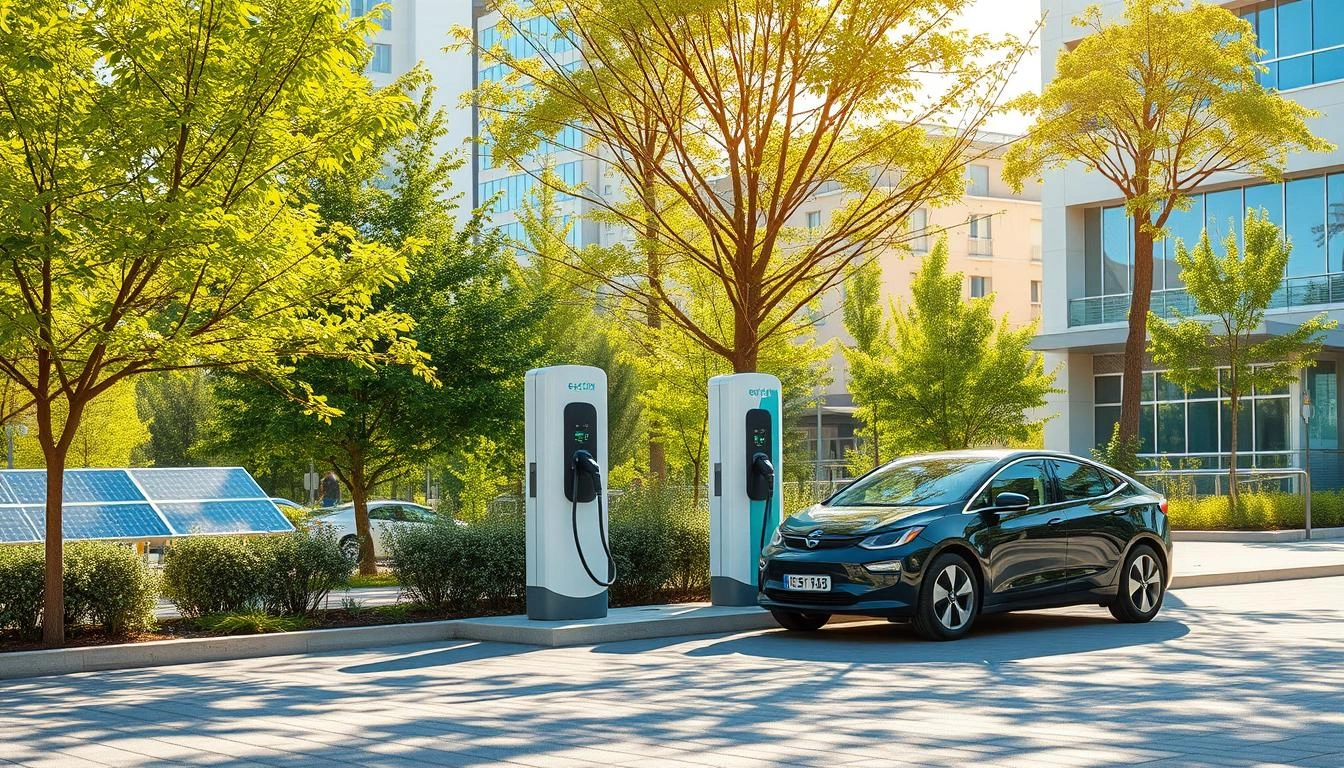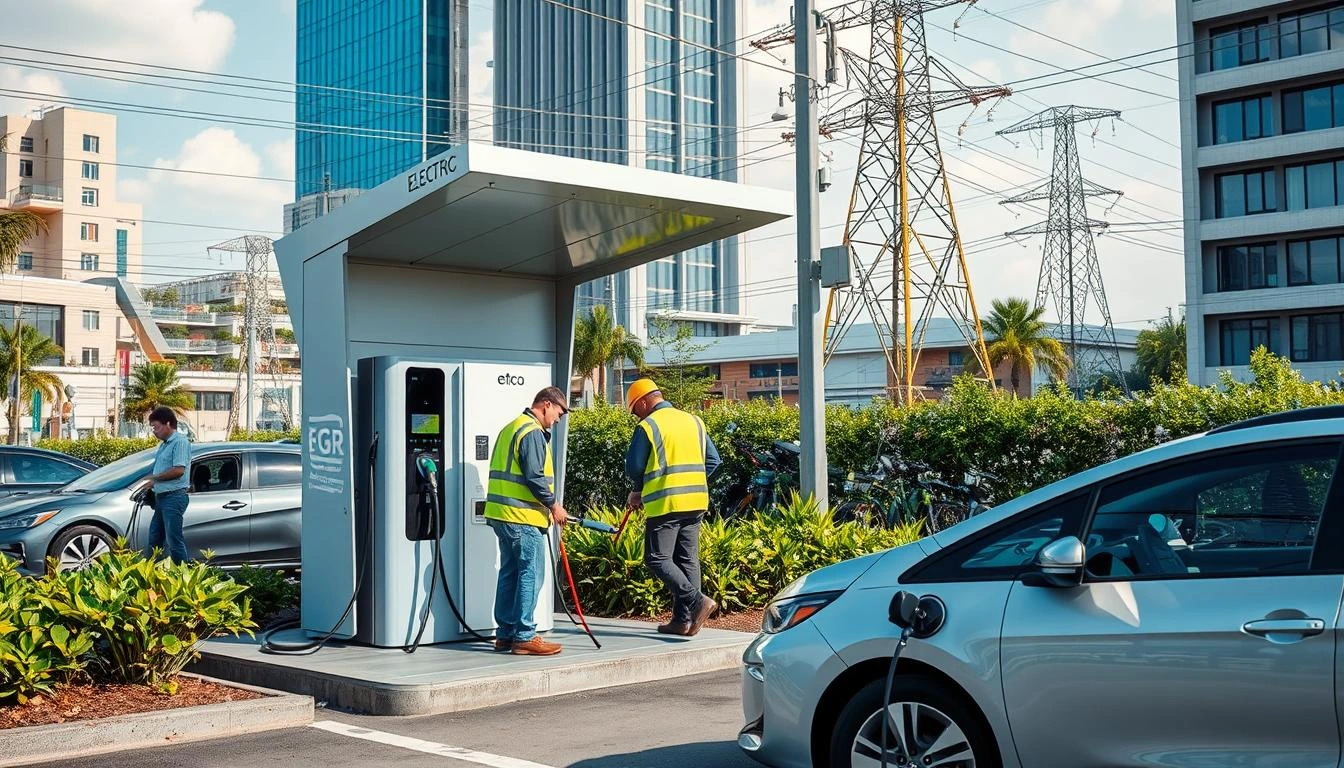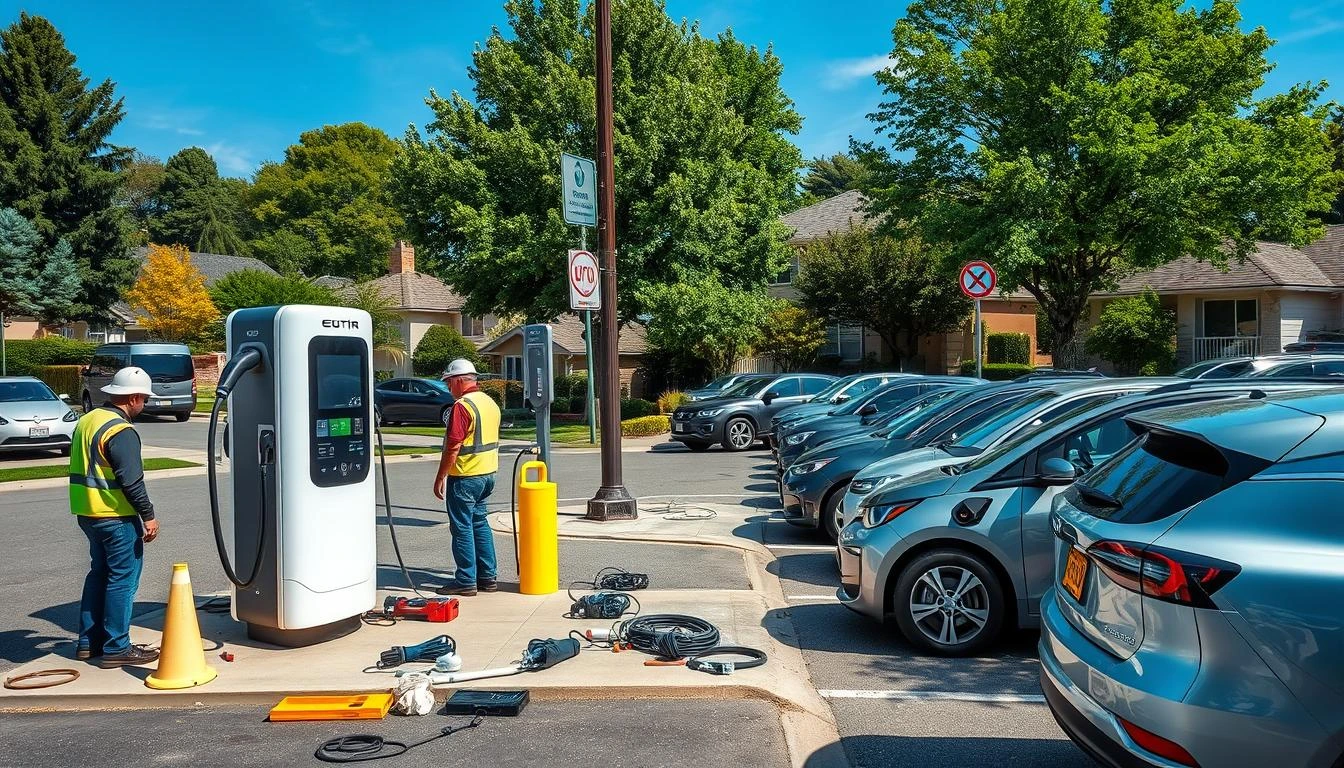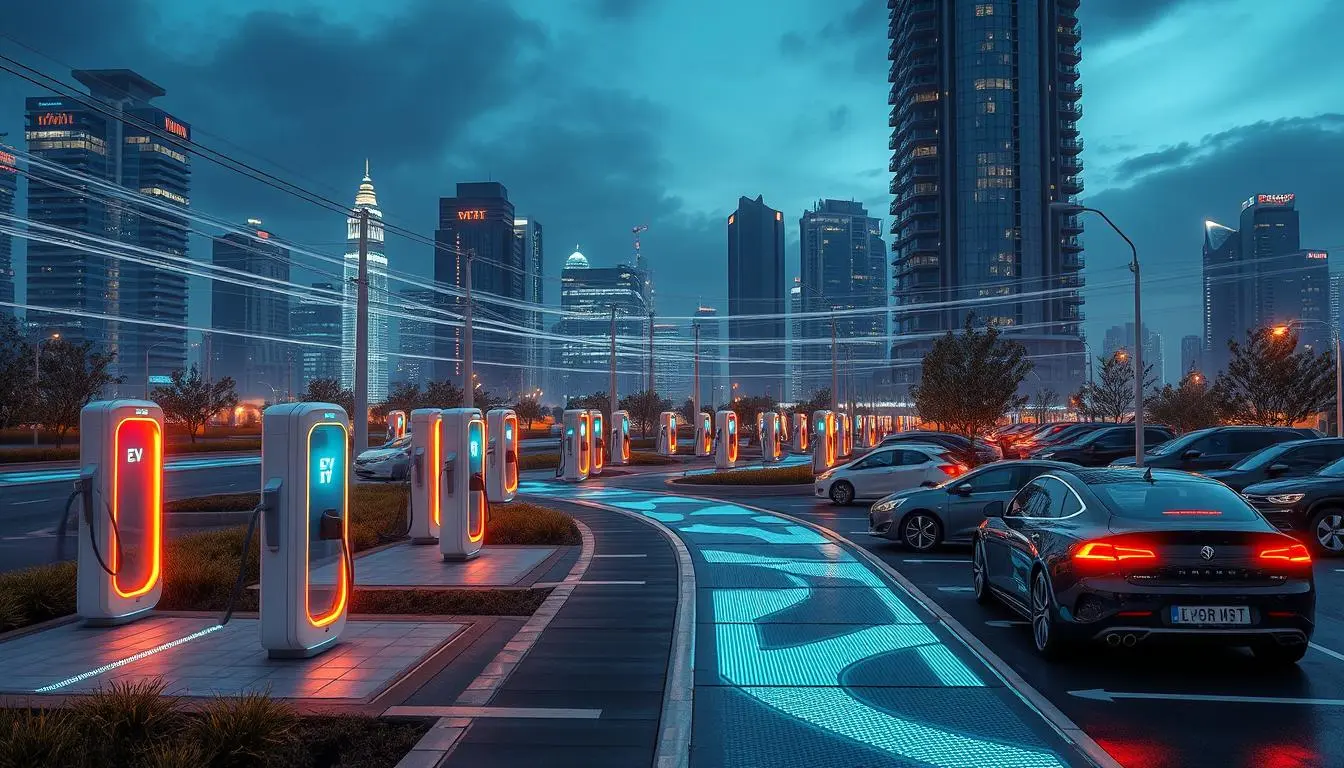
Are you ready to join the future of transportation? Electric vehicles (EVs) are becoming more popular. This means we need more charging stations. This guide will help you install EV charging stations, whether at home, for your business, or for public use.
This article covers everything from the types of charging stations to the rules you need to follow. You’ll learn how to make smart choices and ensure a smooth installation. Get ready to help make transportation greener and join the eco-friendly movement.
Key Takeaways
- Explore the diverse range of EV charging station types and their unique features and requirements.
- Understand the essential components and infrastructure needed for a successful EV charging station installation.
- Learn the steps involved in planning and executing an EV charging station project, from site selection to regulatory compliance.
- Discover best practices for ensuring the safety and efficiency of your EV charging station installation.
- Gain insights into the ongoing management and maintenance of EV charging stations to maximize their performance and longevity.
Understanding EV Charging Station Installation
The electric vehicle (EV) market is growing fast. This means we need a strong ev charging infrastructure more than ever. It’s important to know about the different types of EV charging stations and what they need to work well.
Types of EV Charging Stations
There are three main types of EV charging stations: Level 1, Level 2, and DC fast charging. Each type has its own strengths and meets different charging needs:
- Level 1 Charging: This is the simplest form of charging. It uses a standard household outlet. It’s slow but great for overnight or long-term home charging.
- Level 2 Charging: These stations charge faster and are often found in public or commercial spots. They need a special 240V circuit and charge faster than Level 1.
- DC Fast Charging: Known as Level 3 charging, these stations charge very quickly. They’re perfect for portable ev charging station use on highways and in cities.
Charging Station Components and Requirements
Every electric vehicle supply equipment (EVSE) system needs a few key parts to charge EVs. These include the charging unit, power supply, and how they connect. Each station has its own electrical and installation requirements for safe and efficient use.
Knowing about the different types of EV charging stations and what they need helps us plan better. This way, we can support the growing ev charging infrastructure well.
Planning Your EV Charging Station Project
Installing electric vehicle (EV) charging stations requires careful planning. Choosing the right location and ensuring compliance with regulations are key. This ensures your project’s success.
Site Selection and Feasibility Analysis
Finding the perfect spot for your EV charging station is crucial. Look for places that are easy for EV drivers to reach. Also, consider being close to public areas or commercial spots. Make sure there’s reliable power available.
Doing a detailed analysis helps find the best location. It should meet the needs of your audience and the charging system’s needs.
Permitting and Regulatory Compliance
Setting up EV charging stations involves dealing with many permits and rules. You might need to get permits from local authorities. You also have to follow building codes and electrical safety standards.
Knowing these rules early can save you time. It ensures your installation goes smoothly and meets all requirements.
| Permit Type | Regulatory Body | Typical Requirements |
|---|---|---|
| Electrical Permit | Local Electrical Inspection Department | Detailed electrical plans, safety specifications, and compliance with local electrical codes |
| Building Permit | Local Building Department | Architectural drawings, site plans, and adherence to building codes |
| Zoning Permit | Local Zoning Department | Verification of land use compliance and compatibility with local zoning regulations |
By focusing on site selection, feasibility, and compliance, you set up your EV charging station for success. It will meet your community’s needs and support electric vehicle growth.
Preparing for EV Charging Station Installation
Before starting the installation of an electric vehicle (EV) charging station, it’s important to prepare the site well. This preparation includes several key steps. These steps will make the installation process smooth and efficient.
Obtaining Necessary Permits
The first step is to get the needed permits from local authorities. You might need permits for electrical work, construction, or building modifications. Getting these permits early can prevent delays and ensure you follow all rules.
Coordinating with Utility Providers
Working with your local utility providers is key when planning an electric vehicle charging project. They can check if your electrical system can handle the new demand. Talking to them early helps avoid problems later.
Upgrading Electrical Infrastructure
Installing an ev charging station might mean upgrading your electrical setup. This could mean a new electrical panel, a bigger service capacity, or special circuits for the extra power. A licensed electrician can help figure out what upgrades you need.
| Permit Type | Typical Requirements |
|---|---|
| Electrical Permit | Electrical drawings, load calculations, and compliance with local electrical codes |
| Construction Permit | Site plans, building permits, and compliance with local construction regulations |
| Environmental Permit | Environmental impact assessments and compliance with environmental regulations |
By taking these steps, you can make sure your site is ready for a smooth ev charging station installation. This approach helps avoid delays and ensures you meet all the rules.

electric vehicle charging station installation
Setting up an electric vehicle (EV) charging station is easy if you know the right steps. It’s important to be careful and follow safety rules. This guide will help you install your EV charging station safely and correctly.
Step-by-Step Installation Process
Here’s what you need to do to install an EV charging station:
- First, check the spot where you want to put it. Make sure it’s close to the electrical panel and easy for drivers to get to.
- Next, see if you need to upgrade your electrical service. This depends on how much power the charging station needs.
- Then, mount the charging station on a wall or pedestal. Follow the instructions from the maker.
- After that, connect the power supply. Make sure it’s grounded and meets local electrical codes.
- Last, test the charging station. Make sure it works right and is ready for use.
Safety Considerations and Best Practices
When you install an EV charging station, safety is key. Here are some important tips:
- Electrical safety: Always use a licensed electrician to avoid electrical dangers.
- Structural integrity: Make sure the charging station is securely attached to the wall or pedestal.
- Accessibility and visibility: Place the charging station where it’s easy to find and use.
- Maintenance and inspection: Check the charging station often and do any needed upkeep to keep it safe.

By following these steps and safety tips, you can install your EV charging station safely. This will make driving greener and more convenient for you.
Managing and Maintaining EV Charging Stations
As electric vehicles become more popular, we need better charging systems. Keeping EV charging stations in good shape is key for a successful green transport future. This part talks about the important steps to manage and upkeep these vital parts of our smart charging networks.
Monitoring and Data Analysis
Watching and analyzing data is at the heart of managing EV charging stations well. By keeping an eye on how charging stations work, we can spot problems, use energy better, and make users happier. Using advanced data tools gives us insights into how people charge, how often, and how much energy they use. This helps us plan better and keep stations running smoothly.
Checking important numbers like how long people charge, how much energy they use, and if stations are working helps find and fix issues. This info helps us set up maintenance plans to keep stations reliable and ready for electric car owners.
| Metric | Importance |
|---|---|
| Charging Session Duration | Helps identify usage patterns and potential bottlenecks in the charging network. |
| Energy Usage | Enables optimization of energy consumption and cost-effective operation of the charging infrastructure. |
| Uptime | Ensures the reliability and availability of the charging stations, enhancing the user experience. |
By using data and analytics, we can make smart choices, improve our charging systems, and help more people use electric vehicle charging and zero-emission mobility.

Conclusion
Electric vehicles (EVs) are becoming more popular, making a strong EV charging station network crucial. This guide has covered key points about setting up and managing EV charging stations. It helps businesses, property owners, and cities move towards a greener future.
We’ve looked at the various EV charging stations, their parts, and how to set them up. Knowing this lets readers handle the challenges of this changing field. Following safety rules and best practices is vital for these stations to work well.
Putting in EV charging stations supports electric cars and shows care for the environment. As more people want to charge their cars, those who act early will lead the electric vehicle shift. They’ll see happier customers, a greener planet, and save money in the long run.
FAQ
What are the different types of EV charging stations?
EV charging stations come in three types: Level 1, Level 2, and DC fast charging. Level 1 uses a standard outlet for slow charging. Level 2 charges faster with a 240V outlet. DC fast charging is the quickest but needs special equipment.
What are the key components of an EV charging station?
An EV charging station has three main parts: the charging unit, power supply, and connectivity features. The charging unit connects to the car and delivers electricity. The power supply is the electrical setup. The connectivity features let you monitor and manage it remotely.
How do I select the best location for my EV charging station?
Choose a location that’s easy to get to and close to EV drivers. Make sure there’s enough power and check local rules. A detailed site analysis is key for a successful EV charging station.
What permits and regulations do I need to consider when installing an EV charging station?
Permits and rules vary by location and type of station. You might need building, electrical, and zoning permits. Always check local laws and safety standards before starting.
What are the steps involved in the installation process for an EV charging station?
Installing an EV charging station involves several steps. First, get the necessary permits. Then, upgrade the electrical system and mount the charging unit. Connect the power supply and ensure safety. Always follow safety guidelines and best practices.
How can I monitor and maintain my EV charging station?
Keeping your EV charging station in good shape is crucial. Regularly check its performance and analyze usage data. Implement preventive maintenance to keep it running smoothly. This way, you can fix any problems quickly and ensure it works well.